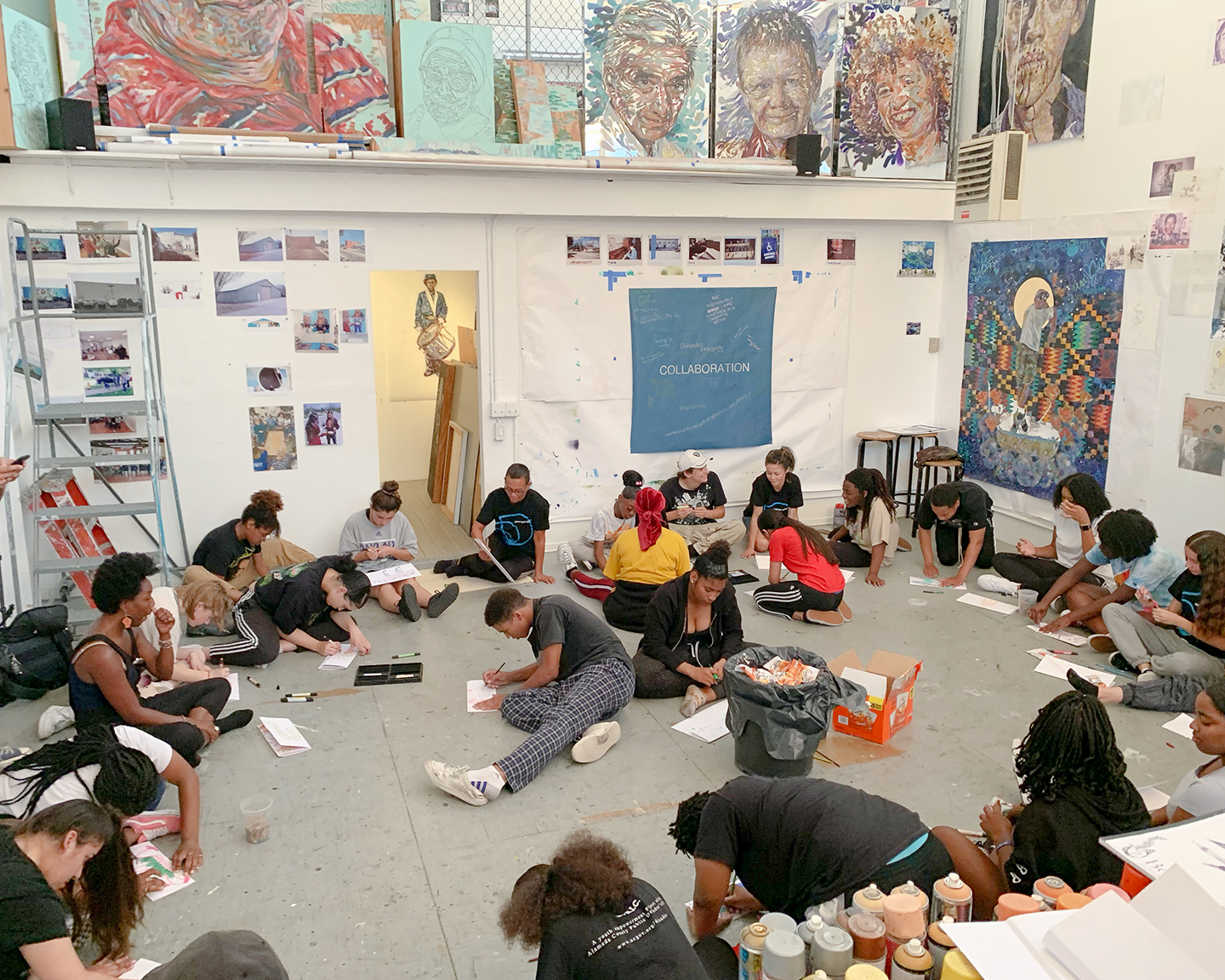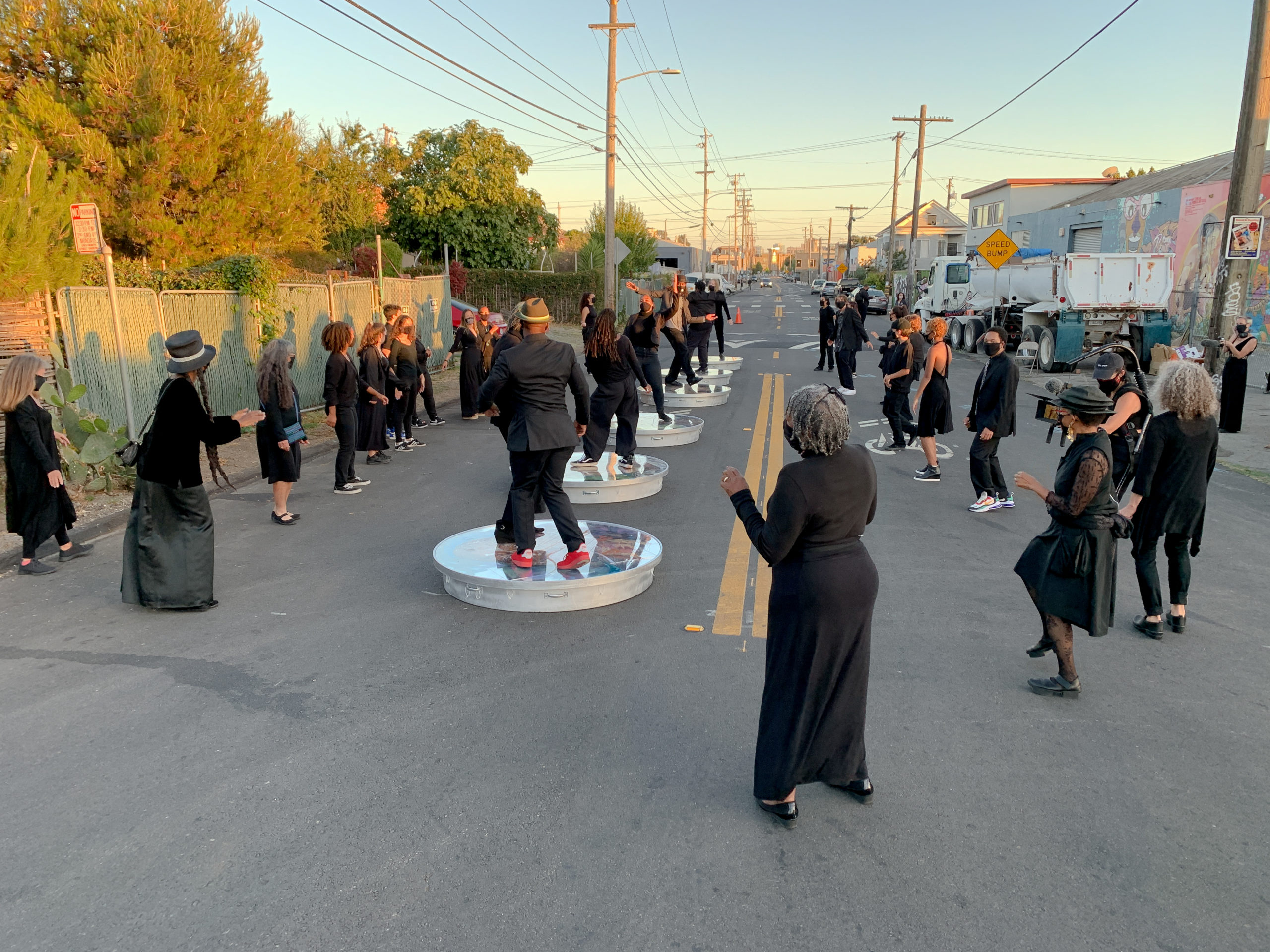Brett Cook is a San Francisco Bay Area-based artist and educator who interweaves creativity, daily life, and social healing in his practice. His installations incorporate painting, drawing, and photography to convey rich perspectives of a community, often in tandem with public workshops involving music, performance, and food.
Recently, Cook was named a recipient of The Rainin Fellowship, receiving a $100,000 unrestricted grant by the Kenneth Rainin Foundation as part of an initiative now in its second year which supports visionary, cross-disciplinary Bay Area artists. Cook’s Public Space Fellowship well reflects his commitment to Bay Area communities.
His latest public art project was The Black W(hole) (2020), a process-based meld of action research, installation, and performance mourning and celebrating six young people who were fatal victims of violence in Oakland, CA. The public ritual, conceived in collaboration with spoken-word poet and playwright Marc Baamuthi Joseph and Destiny Arts Youth Performance Company Artistic Director Sarah Crowell, was inspired by the need for an embodied, community-driven language to memorialize lost young lives while resisting the backdrop of gentrification displacing Black families and cultures.
Whitewall spoke with Cook about the origins of his arts and public education projects, his balancing of fine arts and grassroots activism, community-based work since the pandemic, and future projects.
WHITEWALL: Could you walk us through your early background? Have you wanted to pursue the arts or public education since childhood, or did something later inspire you to blend the two?
BRETT COOK: I was born and raised in San Diego, and moved to Berkeley to study Zoology. Once I realized that life sciences weren’t that compelling, my parents (who were both teachers) encouraged me to study education. I got degrees in both art and education and moved to New York to work at an alternative education at an alternative high school on the Lower East Side. It was a progressive educational site in partnership with five major nonprofit art spaces, and very plugged into the New York art world. It was there that I got exposed to the idea of creation in a radical, pedagogical way!
I was in New York until 2004, then moved to Oaxaca to conduct a learning-through-photography course, and returned to the Bay Area for an Art Institute fellowship in 2005. When I returned I began to more intentionally combine the peer-based, student-integrated learning procedures with the public projects that I had been doing in my neighborhoods since I was young. There certainly weren’t as many fellowship opportunities when I was starting out as there are now! I also began to incorporate the ethnography and community action research which I had conducted when I was young, melding them into a creative discipline by inviting participants into community-driven projects.
WW: What has been your experience in striking that balance between fine art and grassroots work? What are encouragements (or difficulties) specific to the Bay Area?
BC: I internalized the Bay Area notion while pretty young, that artists are only as dynamic as their experiences. I had a joke growing up that I had only gone where Southwest flew — Seattle, Vegas, LA, and so on. Oftentimes there is this stereotype of the Bay Area that it is provincial, in a way not just relating to the arts but to the region as a whole. And so I didn’t move to New York because it was the center of the art world; I was trying to think of a place I could go to that would make me more dynamic as a person. As a Black American, New York was such a compelling place on that cultural front. I believe that moving away benefitted me with that exposure, not only forming a global sensibility but informing my practice with different cultural paradigms.
Unlike New York and other major cities that I was looking at, the Bay is uniquely built on a history of social justice, like the Free Speech Movement and the Black Panthers, queer history and Pride, and well before that, e.g. in education, Berkeley was one of the first cities to voluntarily desegregate. Given all of that it’s no surprise that social justice is still valued in such a unique way now; it’s a large part of why I moved back.

“The Black (W)hole” project beginnings in Brett’s studio/practice Center, courtesy of the artist.
WW: Your artwork has ranged from grand scales — like the Delaware Mural Project — to individual scales — like Art for Change, a program which uses storytelling to expose Oakland Unified School District students to healthcare careers. What advantages and disadvantages does each mode present to you when it comes to community-based work?
BC: I believe that, throughout my career, the scale of a project has been increasingly determined for me by the quality of the partnership. When I was younger and both more ambitious and more individualistic I would do anything that seemed to be altruistic, that seemed to want to change the world and make it a better place, regardless of how. Now I’ve realized that part of what makes those projects so great is the quality of their partnership. The more that the participants are committed to transformation and not doing harm, the more that they are committed to doing the project skillfully, in dialogue, while flattening hierarchies, the easier and more effective that project will be. I have found that projects without that good faith are more difficult.
On the other hand, a lot of this evolution in my work has been about my own transformation. It’s a very intersubjective and another rigorous expectation that you rarely find in conventional fine art; there, you generally create something and there’s rarely a given expectation that you make it while remaining considerate of the outcomes or of the community which you work within. That realization was part of my radical shift: it’s not either/or, you have to be as considerate about the process as you are about the product.

“The Black (W)hole” performance view, courtesy of the artist.
WW: The pandemic has brought great devastation and standstill to communities in the Bay Area, and also great cooperation and healing. How has it influenced your practice, whether changing your focus as an artist, or changing your focus as an activist?
BC: It has been fundamental to my practice to cultivate more skillful relationships, and it has been more difficult over the past three years to maintain those relations as everyone migrates to digital platforms to have those meetings and conversations. Initially, the pandemic made me collapse a lot of my practices so far as community outreach went. At that same time, the communication migration allowed me to continue reaching out to the institutions which were meant to serve these communities. I’ve maintained two major projects to that end; I’m a board member for A Blade of Grass, an arts nonprofit dedicated to providing resources for socially engaged artists, and I’ve maintained a partnership with the Yerba Buena Center for the Arts in San Francisco.
The wobble between my work as artist and activist happens so often because my work is so interdisciplinary and multifaceted. As an organizer, teacher, figure painter, and so on, I can’t identify myself with any one of these things that people see in the work. It’s about a participatory lattice-work of all of these different forms, and the affirmation that everyone involved are such complex beings.

“The Black (W)hole” performance view, courtesy of the artist.
WW: Throughout your career you’ve always tried to use institutions to your advantage as an activist, rather than seeking to explicitly work outside them, and to great benefit to those whom the institutions are meant to serve. How has your approach there evolved over time?
BC: When I was young, while I was studying at Berkeley during the day, I was painting walls everywhere in the middle of the night. It was non-permissional, individual work, very public with no institutional affiliation, but it would make the newspapers and received some early acclaim because it was so pervasive and sociopolitically engaging. I figured then that it was easier to obtain forgiveness than it was to obtain permission; I just wanted to get my work out there so that people would see it.
I later realized that it is not enough to use your art simply to highlight situations that people living them are already quite aware of; the aim of socially engaged art is to create new conditions where those situations are transformed. My experience in New York made me reconsider these institutional entities, not just as facets that I wanted to ignore or critique in my art but as possible means for transforming those situations by working in collaboration. I still have studio projects which I pursue individually, but now there’s a spectrum of collaborative partnership that I look to when it comes to any creative pursuit.
You can’t regard institutions as though they are separate from the communities that they are meant to change for the better, and you can’t regard socially engaged artmaking as though critique alone would make that change. Illustrating those conditions isn’t necessarily embodying and changing them. The activist’s craft is not limited to telling it how it is, and it took a lot of personal experience to transform myself beyond that, to a more targeted impact.

“The Black (W)hole” culminating family gathering, procession and final film shoot, courtesy of the artist.
WW: What’s in the future for you? What projects do you have in mind?
BC: As I’d mentioned, at the beginning of the pandemic I began a collaboration as a Senior Fellow at the Yerba Buena. They asked me and Liz Lerman, a choreographer and MacArthur fellow, to design a project, visual art-based on my end and performance-based on her end, which was projected to take place in a year. It turned into a series of community programming which has taken place over the last three years!
This fall we’re commencing a large presentation of previous work, inspiring existing and new audiences to think about new ways of being and relating to a community-driven arts center. The show will be permeable, with exhibitions taking place indoors and outdoors, culminating with musical performances and artist talks in winter. We’ve been doing this kind of public work for decades, and we hope to show people something completely new about what’s creatively and socially possible, and to inspire local artists to emulate my practice along the lines of immersive exercises in public spaces.






